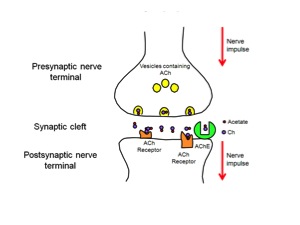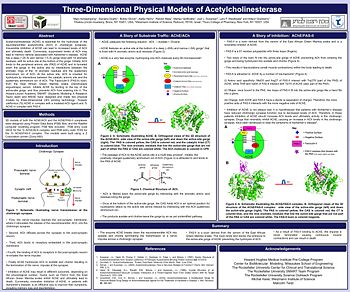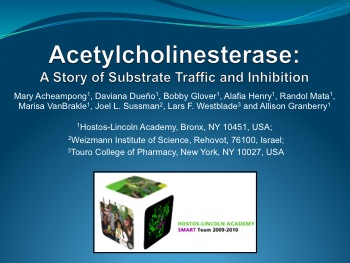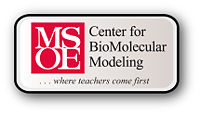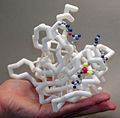Sandbox 350
From Proteopedia
Contents
|
Physical Models of Acetylcholinesterase in Complex with Acetylcholine and the Green Mamba Snake Toxin, Fasciculin-II
Students: Mary Acheampong. Daviana Dueño, Bobby Glover, Alafia Henry, Randol Mata, and Marisa VanBrakle, Hostos-Lincoln Academy.
Teacher: Allison Granberry, Hostos-Lincoln Academy
Mentors: Joel Sussman, Weissman Institule of Science, and Lars Westblade, Touro College of Pharmacy.
Introduction
Acetylcholinesterase(AChE) is essential for the hydrolysis of the neurotransmitter acetylcholine(ACh), and therefore the termination of the nerve impulse in cholinergic synapses. Irreversible inhibition of AChE can lead to increased levels of ACh in cholinergic synapses and ultimately death. Conversely, suppressed levels of ACh may lead to memory deficits associated with Alzheimer's disease. AChE has a deep(20Å) and narrow(5Å) gorge lined with 14 aromatic residues, with its active site at the bottom of the gorge. Initially, ACh binds to the peripheral anionic site(PAS) of AChE and is funneled down the gorge to the active site by interactions between the aromatic rings of the 14 aromatic residues and the quaternary ammonium ion of ACh. At the active site, ACh is oriented for hydrolysis by interactions between the catalytic anionic ion site and the quaternary ammonium ion of ACh. The Fasciculin-II (FAS-II)toxin, a component of the East African Green Mamba snake(Dendroaspis angusticeps) venom, inhibits AChE by binding to the top of the active-site gorge, including residues that form the PAS; thus preventing ACh from entering the active-site gorge. The Hostos-Lincoln Academy Students Modeling A Research Topic(S.M.A.R.T) team and the Center for BioMolecular Modeling have designed and fabricated two physical models using a combination of computational molecular modeling and three-dimensional(3D) printing technology: Torpedo californica(Tc) AChE in complex with a modeled ACh ligand and TcAChE in complex with FAS-II.
Background Information
When a nerve impulse reaches the presynaptic nerve terminal, where it stimulates the release of the neurotransmitter, ACh, into the cholinergic synapse. ACh diffuses across the synapse to the postsynaptic nerve terminal, and binds to receptors embedded in the membrane of the postsynaptic nerve terminal. The binding of ACh to receptors in the postsynaptic neuron re-initiates the nerve impulse. Finally AChE, anchored to the membrane of the postsynaptic nerve terminal, hydrolyzes ACh to acetate and choline resulting in the termination of the nerve impulse at the synapse.
Inhibition of AChE may result in different outcomes, depending on the physiological context. Toxins such as FAS-II from the East African Green Mamba snake inhibit AChE and ultimately lead to death. Conversely, reversible inhibition of AChE, in patients with Alzheimer’s disease, is an effective way to improve their symptoms, including memory loss and disorientation.
|
|
Designing Physical Models to Tell the Story of Acetylcholinesterase
Reflected in our design are two key concepts of AChE biology: the mechanism by which AChE hydrolyses ACh (the substrate traffic story), and how the Green Mamba Snake toxin, FAS-II, inhibits the hydrolysis of ACh (the inhibition story). Two physical models were designed and fabricated using a combination of computational molecular modeling and 3D printing technology: TcAChE in complex with a modeled ACh ligand, and TcAChE in complex with FAS-II. Both models were designed using the respective protein data bank (PDB) files: 2ace for the TcAChE/ACh complex and 1fss for theTcAChE/FAS-II complex, and RasMol computer modeling program.
|
Features of the Substrate Traffic Story:a Model of AChE/ACh
The Tc protein contains 537 amino acids and forms an α/β hydrolase fold. The neurotransmitter consists of an acytoxy group, an ethylene group and a positively charged quaternary ammonium ion.
The that line the active site gorge are Tyr70, Trp84, Trp120, Tyr121, Tyr130, Trp233, Trp279, Phe288, Phe290, Phe330, Phe331, Tyr334, Trp432 and Tyr442. These aromatic residues interact with the positively charged quaternary ammonium ion of ACh by virtue of cation-π interactions to filter it down the active-site gorge to the catalytic triad.
The PAS includes residues . Initially, the positively charged quaternary ammonium ion of ACh is attracted to and binds to the , highlighted in yellow.
The Catalytic Anionic Site (CAS) includes residues . The , highlighted in red, holds ACh in the optimal position for hydrolysis by interacting with the quaternary ammonium ion of ACh.
The AChE active site includes three residues that form a catalytic triad: . The , highlithed in blue, is responsible for the hydrolysis of ACh into acetate and choline.
|
Features of the Inhibition Story: a Model of AChE/FAS-II
The Green Mamba snake toxin, , is a 61-residue protein that folds into 4β sheets, with 3 of the 4β sheets forming loops, or fingers.
FAS-II binds to and inhibits AChE using two major mechanisms:
1. Amino acid specificity: residues are located on two of the three fingers of FAS-II. When FAS-II to AChE, Arg27 and Met33 interact with Trp279 part of the PAS, while Thr8 interact with Tyr70, also part of the PAS.
2. Shape: Once bound to the PAS, two loops of FAS-II fit in to the AChE active-site gorge like a hand fits into a glove. Once this occurs, the entrance of the gorge is such that acetylcholine may not enter, and therefore it will not be hydrolysed. This results in the increased levels of AChE in the cholinergic synapse, and ultimately death.
Poster and Presentations
Our physical models and poster were presented at the 2010 ASBMB meeting in Anaheim, CA.
A power point presentation of our project was given at the 2010 Rockefeller University NYC SMART Teams Annual Symposium.
References
1. Sussman, Joel L., Harel M., Frolow, F., Oefner, Christian, Goldman, Adrian, Toker, Lilly, Silman, Israel (2006). Atomic Structure of Acetylcholinesterase form Torpedo californica: A Prototypic Acetylcholine-Binding Protein in Science 253, 872-879.
2. Goodsell, David, “Acetylcholinesterase.” Protein Data Bank: Molecule of the Month. Web. June 2004.
3. Silman, Israel, Sussman, Joel L. (2008). Acetylcholinesterase: How is Structure Related to Function? In Chemico-Biological Interactions 175(3-10).
4. Harel, Michal, Kleywegt, Gerrad J., Ravelli, Raimond B.G., Silman, Isreal, Sussman, Joel (1995). Crystal Structure of an Acetylcholinesterase-Fasciculin Complex: Interaction of a Three-Fingered Toxin From Snake Venom With Its Target in Structure 3(12), 1355-1366.
5. Greenblatt, Harry M., Dvir, Hay,Silman, Isreal, Sussman, Joel L. (2002). Acetylcholinesterase: A Multidaceted Target for Strucutre-Based Drug Design of Anitcholinesterase Agents for the Treatment of Alzheimer’s Disease in Journal of Molecular Neuroscience 20, 369-383.
Acknowledgements
1. Howard Hughes Medical Institue Pre-College Program
2. Center for BioMolecular Modeling, Milwaukee School of Engineering
3. The Rockefeller University Center for Clinical and Translational Science
4. The Rockefeller University S.M.A.R.T Team Program
5. The Rockefeller University Science Outreach Program
6. Touro College of Pharmacy
7. Michal Harel, Weizmann Institute of Science
8. Malcolm Twist
MSOE Center for BioMolecular Modeling and SMART Teams
SMART Teams (Students Modeling A Research Topic) is a science outreach program developed by the MSOE Center for BioMolecular Modeling. In this program, teams of high school students work with a local resarch lab to design and build a physical model of a protein that is being investigated by the lab. The goal of the SMART Team program is to introduce students to the real world of science --- as it exists in a local research lab. The development of this program was supported by grants from the NIH-NCRR SEPA program (Science Education Partnership Award) and an HHMI Precollege Science Education Award. For more information about this program, visit the SMART Teams Proteopedia home page or visit the CBM web site at www.rpc.msoe.edu/cbm.
